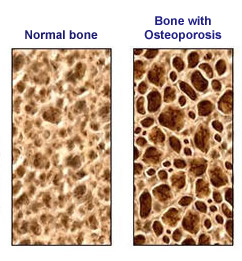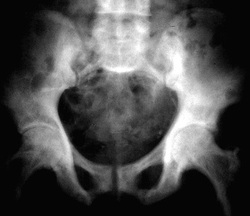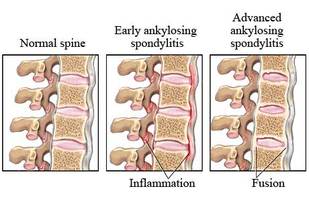Spondylogenic Causes of Sacral/Sacroiliac Pain
Spondlyogenic causes of sacral/sacroiliac pain can be derived from a number of structures such as bone, ligaments, or muscles. Fractures (traumatic, insufficiency, pathologic), metabolic bone disease, osteoporosis, Paget's disease, Ankylosing Spondylitis, and osteoarthritis can all be spondylogenic causes of SI pain.
Osteoporosis

Osteoporosis is a silent disease with no visible signs or symptoms until bone loss is sufficient to result in a fracture. Common fracture sites include: proximal femur, vertebrae, hip, pelvis, proximal humerus, distal radius, and tibia.
Risk Factors for Osteoporosis
Women
- Caucasian and Asian women are more likely to develop osteoporosis; African-American and Hispanic women have a significant risk for developing osteoporosis
- Gender, more common in women
- Age: older than 65
- Postmenopausal
- Family history of osteoporosis
- Family or personal history of fractures
- Lifestyle: smoking, excessive alcohol intake, inadequate calcium, little or no weight bearing exercise, sedentary lifestyle
- Prolonged exposure to certain medications (more than 6 months): thyroid medications, corticosteroids, anti-inflammatories, anti-seizure medication, aluminum-containing antacids, lithium, anticoagulants, benzodiazepines.
- Thin small-boned frame, less than or equal to 125 pounds
- Chronic diseases that affect kidneys, lungs, stomach, intestines or alter hormones
- Caucasian
- Advancing age
- Lifestyle: same as above
- Prolonged exposure to certain medications: same as above
- Family history
- History of prostate cancer with bilateral orchiectomy
- Undiagnosed low levels of testosterone
- Hypogonadism (long-term androgen deprivation therapy or ADT)
- Chronic diseases: same as above
Clinical Signs and Symptoms of Osteoporosis
- Mild to severe back pain (low thoracic, high lumbar)
- loss of height (more than 1 inch)
- x-ray films depicting 30% loss of bone mineral density
- bone fracture/deformity
- pain
- Kyphosis
- Dowager's hump
- Decreased activity tolerance
- Early Satiety
Risk Factors for Sacral Fractures
- Osteoporosis
- Paget's disease
- Gender (female)
- Athletes, military personnel (overuse, overtraining, improper footwear or training surface)
- Athletic pregnant or postpartum women
- Pelvic radiation
- Lumbar- sacral fusion (early postoperative)
- Osteomyelitis
- Multiple myeloma
- Trauma
- Prolonged use of coticosteroids
Paget's Disease

Paget's Disease is the most common skeletal disorder after osteoporosis. It is most commonly seen in elderly individuals over the age of 70, most of which are asymptomatic. Paget's Disease is characterized by slowly progressive enlargement and deformity of multiple bones, it is associated with unexplained acceleration of bone deposition and resorption. The bones become weak, spongy, and deformed. Redness and warmth maybe noted over involved areas and the most common symptom is bone pain. The most commonly involved structures include in decreasing order are: pelvis, lumbar spine, sacrum, femur, tibia, skull, shoulders, thoracic spine, cervical spine, and ribs.
Clinical Signs and Symptoms
- Pain and stiffness
- Fatigue
- Headaches and dizziness
- Bone fractures
- Vertebral compression and collapse
- Deformity
- Bowing of long bones
- Increased size and abnormal contour of clavicles
- Osteoarthritis of adjacent joints
- Acetabular protrusion
- Head enlargement
- Periosteal tenderness
- Increased skin temperature over long bones
- Compression neuropathy
- Spinal stenosis
- Paresis
- Paraplegia
- Muscle weakness
Ankylosing Spondylitis

Ankylosing Spondylitis is a chronic, progressive inflammatory disease of an undetermined cause. It causes inflammation of the fibrous tissue affecting the insertions of ligaments, tendons, and capsules into bone. The sacroiliac joints, spine, and large peripheral joints are primarily affected.
Clinical Signs and Symptoms
Early Stages
- Intermittent low back pain
- Sacroiliitis
- Spasm of paravertebral muscles
- Loss of normal lumbar lordosis
- Intermittent, low grade fever
- Fatigue
- Anorexia, weight loss
- Anemia
- Painful limitation of cervical joint motion
- Constant low back pain
- Loss of normal lumbar lordosis
- Ankylosis of the sacroiliac joints and spine
- Muscle wasting in shoulder and pelvic girdles
- Marked dorsocervical kyphosis
- Arthritis of peripheral joints
- Hip flexion in standing
- Cauda Equina Syndrome
- Iritis or iridocyclitis
- Conjunctivitis
- Carditis
- Pericarditis and pulmonary fibrosis (rare)
- Prostatis
Step by Step Screening Process:
1: Review patient's past medical history, age, patient presentation, and family history
2: Assess risk factors/signs and symptoms of Osteoporosis
3: Assess risk factors for possible sacral fracture
4: Assess signs and symptoms for possible pathologies such as Ankylosing Spondylitis or Paget's Disease
5: Ask patient for imaging and confirm with physician on any pathologies present
2: Assess risk factors/signs and symptoms of Osteoporosis
3: Assess risk factors for possible sacral fracture
4: Assess signs and symptoms for possible pathologies such as Ankylosing Spondylitis or Paget's Disease
5: Ask patient for imaging and confirm with physician on any pathologies present
